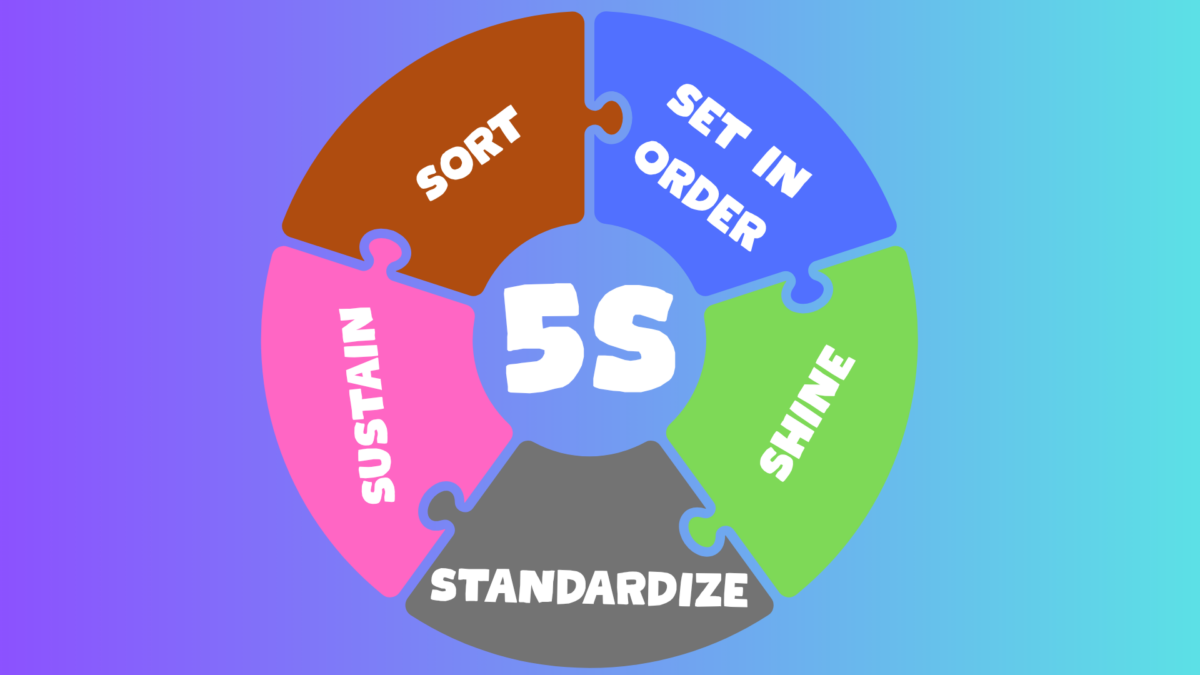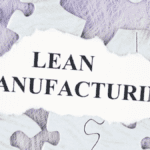
Spis treści
Why 5S and Lean Manufacturing Go Hand-in-Hand
In the manufacturing industry, achieving continuous improvement and operational efficiency requires not just new machines but a culture that relentlessly reduces waste. The fusion of the 5S five-step methodology with lean manufacturing principles—the very foundation of the Toyota Production System—provides a powerful, specific stand-alone workplace organization method for transforming any shop floor into a visual workplace. The core elements of 5S—Sort, Set in Order, Shine, Standardize, and Sustain—form the basis for efficiency and structure. By combining these core elements with broader lean practices like value stream mapping and pull systems, manufacturing organizations implement a productive work environment that:
- Eliminates waste in materials, motion, and time
- Creates an organized working environment with visual management and visual cues
- Drives operational excellence across production lines and manufacturing processes
- Boosts employee engagement and morale through active involvement
- Helps optimize productivity in manufacturing settings
Get started now: Enroll in our comprehensive 5S Lean Manufacturing Course for expert-led training and practical tools.
The History and Origins of 5S
The 5S methodology originated in Japan, where the Toyota Motor Company developed it as a foundational element of the Toyota Production System (TPS). As Toyota sought to revolutionize its production process, the company recognized that accurate lean manufacturing required more than just efficient machinery—it demanded a disciplined approach to workplace organization. The 5S methodology was developed to support continuous improvement by creating a work environment where efficiency and order were the norm. The five Japanese terms—Seiri, Seiton, Seiso, Seiketsu, and Shitsuke—translate to Sort, Set in Order, Shine, Standardize, and Sustain. These steps form a systematic process that organizations implement to eliminate waste, streamline operations, and foster a culture of ongoing improvement. Today, the 5S methodology is recognized worldwide as a cornerstone of lean manufacturing, enabling organizations across every industry to achieve higher levels of efficiency and productivity.
The Five Steps of 5S in a Lean Context
Sort (Seiri): Clearing the Clutter
- Objective: Remove unnecessary items, broken tools, and hazardous materials from your work environment to help the worker maintain an efficient and safe workspace.
- Action: The worker conducts a red-tag event, tagging and relocating or disposing of all non-critical materials to identify and eliminate waste from the area.
- Lean Impact: Reduces waiting time, wasted motion, and the risk of quality issues by ensuring only necessary resources are used and minimizing waste in the workflow.
Set in Order (Seiton): Organize for Flow
- Objective: Arrange the remaining tools, parts, and equipment in a logical order so that frequently used items are easily accessible.
- Action: Map out production lines, assign fixed locations, and install visual controls such as shadow boards and color-coded bins. Ensure the right tools are available at each workstation, with proper tool storage and retrieval for all remaining items.
- Lean Impact: Cuts unnecessary movement, accelerates time efficiency, and supports just-in-time flow by creating an orderly workplace that promotes efficient workflow.
Shine (Seiso): Clean and Inspect
- Objective: Maintain a clean and safe workplace through regular basic cleaning and inspections, thereby supporting worker health and overall well-being.
- Action: Schedule daily cleaning tasks and involve maintenance teams to identify leaks and areas of wear.
- Lean Impact: Improves patient safety in healthcare or reduces downtime in manufacturing, uncovering defects before they halt production, and enhances employee well-being by providing a healthier work environment.
Standardize (Seiketsu): Document Best Practices
- Objective: Create consistent standardized work procedures that everyone follows.
- Action: Develop checklists, visual workplace guides, and key performance indicators to track compliance, ensuring each step is part of a documented repeatable process.
- Lean Impact: Embeds 5S into daily routines by establishing a repeatable process that ensures consistency, reduces errors, and enables improvements to scale across manufacturing facilities.
Sustain (Shitsuke): Drive Cultural Change
- Objective: Ensure 5S becomes a permanent part of your continuous improvement journey by making it a regular practice integrated into daily routines.
- Action: Conduct regular audits, celebrate successes, and build employee buy-in through recognition and training. Involve workers at every stage to sustain the practice and encourage team participation.
- Lean Impact: Creates a disciplined workplace where maintaining order is second nature, driving long-term success. Sustaining 5S improves working conditions for everyone by promoting organization, safety, and efficiency.
Master all five steps—sign up for our 5S Lean Manufacturing Course for templates, case studies, and expert coaching.
Stream Mapping and Value Stream Mapping: Visualizing Waste and Flow
In lean manufacturing, visual tools such as stream mapping and value stream mapping are crucial for identifying and eliminating waste throughout the production process. Stream mapping provides a clear, visual overview of workflow, making it easier to spot inefficiencies, bottlenecks, and unnecessary steps. Value stream mapping takes this analysis further by mapping the entire journey of materials and information—from raw inputs to finished products—highlighting every stage where value is added or lost. By leveraging these tools, organizations can pinpoint where to reduce waste, improve efficiency, and maintain organization across their manufacturing processes. Integrating stream mapping with the 5S methodology ensures that improvements are targeted, measurable, and sustainable, making it a key element in driving productivity and operational excellence.
Integrating 5S with Lean Manufacturing Practices
- Value Stream Mapping: Visualize end-to-end workflows at the organizational level, pinpointing waste before implementing 5S zones.
- Pull Systems and Kanban: Once workstations are organized, use pull signals to match production to actual demand.
- Standard Work and Kaizen: Leverage the stable foundation that 5S provides to run rapid improvement events and refine processes across the organization.
- Key Performance Indicators: Monitor metrics like cycle time, defect rates, and audit scores to drive continuous improvement.
- Visual Management and Visual Factory: Integrate visual factory principles into visual management to enhance efficiency and organization, supporting Just-in-Time manufacturing within Lean practices.
This broader construct of lean thinking ensures that 5S isn’t an isolated project but a key element of your overall operational excellence strategy at the organizational level.
Employee Engagement and Participation: The Heart of Sustainable 5S
Sustaining the benefits of the 5S methodology depends on active employee engagement and participation at every level. When employees are involved in organizing their work environment and identifying sources of waste, they become invested in the process and its outcomes. Building participation not only fosters a sense of ownership but also drives continuous improvement, as employees are empowered to suggest and implement changes that enhance productivity and efficiency. Organizations that prioritize employee engagement and buy-in tend to achieve greater success in maintaining 5S practices, as teams collaborate to uphold standards and drive ongoing progress. By making employees central to the 5S journey, organizations cultivate a culture where continuous improvement is the norm, ensuring a work environment that remains efficient and organized.
Measurable Benefits of 5S and Lean Manufacturing
- Waste Reduction: Less excess inventory, fewer defects, and minimized unnecessary motion.
- Improved Efficiency: Faster setups and smoother workflows boost productivity on the manufacturing floor.
- Improved Safety: Clear work areas and controlled hazardous materials lead to enhanced safety by reducing accidents and risk.
- Employee Engagement: Teams take ownership of their workstations, driving a high-morale, active involvement culture.
- Quality Uplift: A cleaner, more organized environment leads to fewer errors and stronger compliance.
Organizations that implement 5S within a lean framework typically experience double-digit improvements in cycle time and quality metrics within a few months.
Overcoming Challenges and Obstacles in 5S Implementation
Implementing 5S is not without its challenges. Organizations often encounter resistance to change, inconsistent employee engagement, and difficulties in sustaining new practices over time. To overcome these obstacles, clear communication and comprehensive training are essential. Leadership must actively support the initiative by providing employees with the necessary tools and resources to succeed. Regular audits and assessments help reinforce standards, identify gaps, and celebrate progress, ensuring that 5S practices remain practical and relevant. By addressing challenges proactively and fostering a culture of open feedback, organizations can build resilience and ensure the long-term success of their 5S implementation.
Top Industries That Use 5S
The 5S methodology has proven its value across a wide range of industries, far beyond its manufacturing roots. In the manufacturing industry, 5S is a crucial component of lean manufacturing practices, enhancing efficiency and minimizing waste throughout the production process. Healthcare organizations utilize the 5S methodology to improve patient safety, reduce errors, and promote a more organized work environment for staff. Educational institutions apply 5S principles to promote productive, clutter-free learning spaces. The retail, hospitality, and technology sectors also benefit from 5S, as it improves efficiency, safety, and overall workplace organization. No matter the industry, organizations that implement 5S experience a more productive work environment, streamlined processes, and measurable improvements in efficiency and safety.
Getting Started: Your 5S Lean Manufacturing Roadmap.
- Kickoff Workshop with leadership to align on objectives.
- Red Tag Blitz to Sort and clear clutter.
- Zone Design leveraging visual cues and shadow boards.
- Shine Sprints integrates maintenance and cleaning.
- Standard Work Rollout with training for all employees.
- Sustainment Plan featuring audits, performance boards, and recognition events.
By following this structured approach, your team leaders can accelerate the streamlining of the workflow process and embed lean thinking at every level.
Conclusion: Embrace 5S and Lean Manufacturing for Lasting Impact
The Lean 5S methodology is not just about tidiness—it’s a core element of a high-performance, waste-free organization. When combined with lean manufacturing practices, it unlocks operational efficiency, enhances customer satisfaction, and empowers employees to continually refine their work.
🎯 Take the first step toward world-class lean operations—enroll in our 5S Lean Manufacturing Course and lead your organization to excellence.


